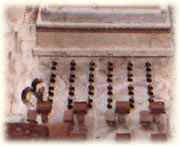North of the Altar was the Butchering Place where the sacrificial animals were slaughtered and butchered. It included:

The Eight Columns
In the northern section of the Butchering Place were eight small columns. Resting on each column was a block of cedar wood with nine hooks attached to it. The slaughtered carcass of the sacrificial animal was hung on these hooks in order to remove the skin and butcher the animal.
The hooks were set into the northern side of the wood, three on the eastern side, and three on the southern side. There were no hooks on the western side, so that the priest did not have to turn his back to the Holy of Holies as he was butchering the animal.
The Eight Tables
Nearby were eight tables that served several purposes. The meat was washed on these tables before it was cooked and eaten by the priests. The animal parts offered on the Altar also had to be washed. The tables kept the carcass from touching the ground as it was being butchered. These tables could fold so they could be moved around as needed.

The Twenty-four Hoops
North of the Altar were twenty-four hoops set into the ground. During the earlier years of the Second Temple, the priest would make a slit in the animal's forehead before slaughtering it. The painless incision caused blood to flow, distracting the animal.
The High Priest Yochanan abolished the practice, lest it might be thought that the slit constituted a blemish and the Temple was offering blemished animals. He decreed that hoops be set into the ground, and the animal's head be inserted to keep it steady.

The Eight Columns
In the northern section of the Butchering Place were eight small columns. Resting on each column was a block of cedar wood with nine hooks attached to it. The slaughtered carcass of the sacrificial animal was hung on these hooks in order to remove the skin and butcher the animal.
The hooks were set into the northern side of the wood, three on the eastern side, and three on the southern side. There were no hooks on the western side, so that the priest did not have to turn his back to the Holy of Holies as he was butchering the animal.
The Eight Tables
Nearby were eight tables that served several purposes. The meat was washed on these tables before it was cooked and eaten by the priests. The animal parts offered on the Altar also had to be washed. The tables kept the carcass from touching the ground as it was being butchered. These tables could fold so they could be moved around as needed.

The Twenty-four Hoops
North of the Altar were twenty-four hoops set into the ground. During the earlier years of the Second Temple, the priest would make a slit in the animal's forehead before slaughtering it. The painless incision caused blood to flow, distracting the animal.
The High Priest Yochanan abolished the practice, lest it might be thought that the slit constituted a blemish and the Temple was offering blemished animals. He decreed that hoops be set into the ground, and the animal's head be inserted to keep it steady.
No comments:
Post a Comment